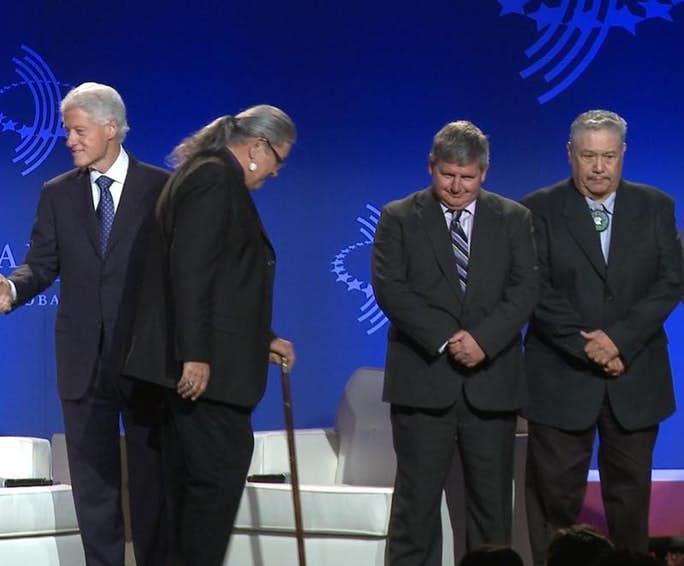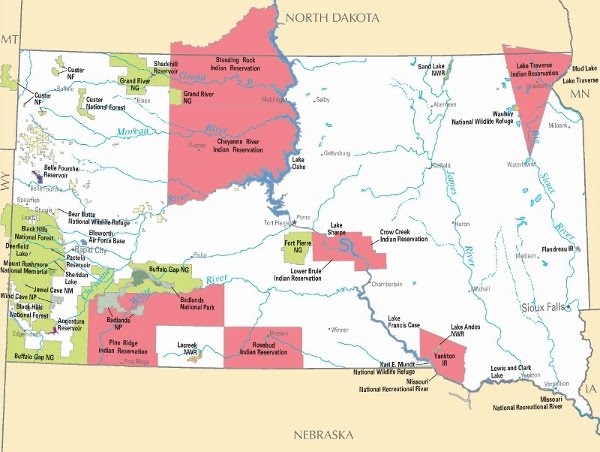 |
Canku Ota
|
 |
|
(Many Paths)
|
||
|
An Online Newsletter
Celebrating Native America
|
||
|
December 2018 - Volume
16 Number 12
|
||
|
|
||
|
It's Clear Sailing
For A Giant Sioux Wind Power Enterprise
|
||
|
by Stephanie Woodard
- Indian Country Today
|
||
|
It's
Clear Sailing for a Giant Sioux Wind Power Enterprise
Called the 'Saudi Arabia of wind power,' the Great Plains could fulfill U.S. energy needs several times over with emissions-free, wind-generated electricity A coalition of Sioux tribes is poised to harness the wind. Long held sacred by the Great Sioux Nation, or Oceti Sakowin, the wind may soon provide tribal communities with clean, renewable power and sustainable economic development. 'We tribes see ourselves as custodians of the environment,' said Oceti Sakowin Power Authority (OSPA) board member Dan Gargan, Rosebud Sioux. 'Producing clean energy is something we've wanted for a long time.' The endeavor has taken a lot of work, and in the process obstacles have become assets. Oceti Sakowin means 'Great Sioux Nation' in Lakota/Dakota, and its vision encompasses the possibility that even more Sioux nations in the U.S. and Canada might join in, according to Caroline Herron of Herron Consulting, which has been involved in OSPA since its beginnings. OSPA's eventual capacity is currently estimated at about two gigawatts, making it an immense utility-scale project and the first joint power authority formed in this country in decades. In a Huffington Post op-ed, retired U.S. Senator Byron Dorgan (D-ND) lauded the project for its innovation and potential. Dorgan called the northern Plains the 'Saudi Arabia of wind power' and claimed the region could fulfill the U.S.'s entire energy needs several times over with emissions-free, wind-generated electricity. Various Sioux tribal associations have explored the idea since the 1980s. Rosebud has installed solar panels on the roofs of some homes, with the electricity produced feeding into the home, and individual tribes have tried setting up wind farms, though these have stalled, generally because they were too small-scale. 'It takes a lot of money to develop a wind farm,' explained Gargan. 'Working together, we tribes can build on a larger scale, find collateral for loans more easily and identify bigger purchasers.' It may be hard for people who don't live in the Plains to understand how windy it is, Gargan added. When he installed a wind-speed meter outside his Rosebud home, he measured frequent gusts up to 70 miles per hour. Finding advantageous financing and major purchasers for the large amount of wind-generated electricity OSPA will produce demanded innovative thinking. The consortium has devised a strategy that will give it ownership of its facilities and access to major markets. The Clinton Global Initiative (CGI) is especially supportive, with President Bill Clinton calling OSPA 'one of my favorite commitments.' When the project is up and running, Clinton told a 2013 CGI conference in Chicago, additional tribes will realize that green energy can allow them to earn substantial money, invest in their communities and diversify their economic base. 'This has been an obsession of mine since I was president,' Clinton said.
The Bush Foundation, Northwest Area Foundation, Rockefeller Philanthropy Advisors and the law firm Arent Fox have also assisted OSPA. The Bureau of Indian Affairs helped by working with the Department of Energy to fast-track OSPA's incorporation under federal law. OSPA will soon select a developer/operator partner for project completion and set a timeline for future stages, Gargan said. These include constructing arrays of wind turbines, each producing one to two megawatts, on the participating tribes' land. Proposed sites are being evaluated for wind speed, access to transmission lines and roads, and environmental and cultural issues. A few sites have been dropped because of the presence of culturally significant features, nesting eagles and other factors. The consortium's biggest hurdle was identifying potential buyers for its electricity, according to Gargan. Local cooperatives providing electricity throughout South Dakota purchase minimal green energy, so OSPA ended up turning to the far larger national wholesale market. This in turn means the authority has a long list of potential customers in more than two dozen central and western states: investor-owned and public utilities, call centers, warehouse distribution centers, and huge energy-hungry corporations, like Amazon and Google, that purchase green energy as part of their corporate mission. In late 2016, Google announced that renewable energy, primarily wind, would supply 100 percent of its power needs by this year. The big companies' market share keeps expanding, said Herron: 'In 2015, corporations bought more than fifty percent of wind energy for the first time, which was more even than the utilities.' Financing posed additional challenges—and ultimately opportunities—for OSPA. In the past, private-equity investors typically offered tribes wind-power deals that involved leasing tribal land, erecting turbines, taking advantage of federal tax breaks, paying the tribe royalties, and then, after 10 years, turning the facility over to the tribe, according to Gargan. The trouble with these arrangements, Gargan said, is that the investors would receive the lion's share of the benefits, then leave the tribe with 10-year-old turbines and no power purchase agreement in place. Even worse, added Herron, such investors usually don't plan a reserve fund for repairing and replacing worn equipment. It's a rare tribe that accepts such a deal. As a consequence, there are very few wind farms on tribal land, said Herron. That's despite many tribes being in regions with lots of sun and wind that could be transformed into clean energy, according to Clinton. OSPA is looking for a partner that would be in it for the long haul, put aside money for repairs and agree to the tribes' retaining project ownership. The biggest financing hurdle has been the tribes' tax-exempt status and resultant inability to take advantage of federal tax breaks (unlike private-equity investors). To be competitive without tax breaks, OSPA's financing model will involve offering bonds, similar to municipal bonds, with which local governments finance anything from a new fire truck to a major construction project. 'The bonds would then be purchased, probably in large chunks, by institutional investors such as pension funds,' said Herron. Electricity and revenue are just the beginning of OSPA's benefits to participating tribes. Taxes on materials and construction will deliver additional revenue, and an estimated 550 jobs will be developed with tribal colleges and Tribal Employment Rights Offices, also called TERO offices. OSPA will help tribal members create related enterprises, such as the concrete companies needed to pour pads for the turbines. Through projects like OSPA, tribes will contribute to U.S. energy independence while building a better future for their children, according to Clinton. 'The potential for this is staggering,' he said. |
||||
|
|
|
||
|
|
||
| Canku Ota is a free Newsletter celebrating Native America, its traditions and accomplishments . We do not provide subscriber or visitor names to anyone. Some articles presented in Canku Ota may contain copyright material. We have received appropriate permissions for republishing any articles. Material appearing here is distributed without profit or monetary gain to those who have expressed an interest. This is in accordance with Title 17 U.S.C. Section 107. | ||
|
Canku Ota is a copyright ©
2000 - 2018 of Vicki Williams Barry and Paul Barry.
|
||
 |
 |
|
|
The "Canku
Ota - A Newsletter Celebrating Native America" web site and
its design is the
|
||
|
Copyright ©
1999 - 2018 of Paul C. Barry.
|
||
|
All Rights Reserved.
|
||


